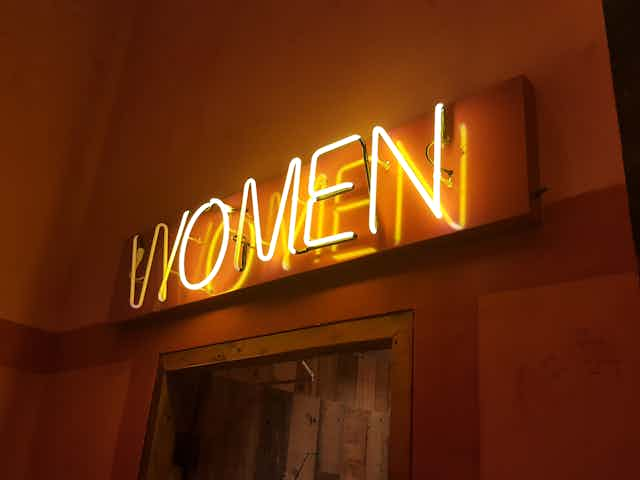Let’s try a thought experiment. Imagine a world in which human members of the biological category “female” aren’t systematically disadvantaged. Imagine that being female is not statistically correlated with any worse outcome, relative to males: in economic status, career advancement, childhood sexual abuse, objectification in the media, or political representation, for instance. Imagine that girls and boys are treated exactly alike, developmentally. Imagine, too, a world in which males and females have equal strength, and where there are no significant patterns of male violence against females, sexual or otherwise. In this imaginary world, would it matter if certain males were counted as females, simply on the basis of saying they were? Arguably, no.
But this isn’t our world. A range of structural inequalities between females and males are widely recognised. These material facts about female oppression must be acknowledged when we think about two questions at the heart of a bitterly disputed UK government consultation on reforming the Gender Recognition Act. The first is whether self-identifying as a woman without medical certification should be sufficient criteria for legal gender reassignment. The second is whether self-identifying transwomen should be allowed into women-only spaces, and have access to women-only resources. Some answer “yes” to both. Others, like me, argue that a positive answer poses unacceptable harm to the original occupants of the category “woman”.
It seems clear that woman-only spaces such as changing rooms, hostels, and prisons should be organised according to sex category, not self-assigned gender. Transwomen are biologically male. Studies show that most retain male genitalia. Many have a sexual orientation towards females. If we think there are good reasons to retain same-sex spaces generally, in terms of protecting females from a small number of malfeasant males, these reasons don’t cease to operate when males self-identify as women. Either we keep same-sex spaces, or the result is effectively mixed-sex spaces, to the detriment of females.
Meanwhile, allowing self-identification as the criterion of eligibility into woman-only resources, such as shortlists and prizes, seems to both incentivise unscrupulous cheating, and count as a stunning dismissal of the original reasons such (still scarce) resources were created – to combat the low numbers of females in associated roles. (This was recently starkly illustrated by the inclusion of Philip Bunce, a biologically male “non-binary” Credit Suisse director, in a Financial Times list of 100 top “female” executives).
Common objections
Here are five familiar objections to such points. The first says: “But transwomen are women.” Assuming that the purpose of the protections and resources in question is to help females, this settles nothing. Transwomen are not biologically female.
The next objection says there’s no such thing as being female. One route is to say that “sex is a social construct”. This is implausible. Though sex has a contingent social meaning – often referred to as “gender” - nonetheless there’s an underlying biological reality too. This underlying reality is responsible for the procreation of our species. (Incidentally, if gender is the social meaning of sex, this is also impossible to “self-identify” into. Social meanings are imposed on us by society).
Another route is to say that “sex is a spectrum”, citing intersex people. Actually this is false: a bimodal distribution (male and female), with predictable outliers (intersex people), isn’t a spectrum. Either way, it’s a red herring. The inequalities faced by females aren’t their inheritance because they really are female, in some technical sense; it’s because they are socially categorised as female, in a “folk scientific” sense. This applies just as much to intersex as it does to “standard” females. As long as oppressive inequalities are distinctively correlated with this social categorisation, then we should fully maintain protections and resources for that group, in mitigation.
The next objection denies that there are, in fact, inequalities distinctively correlated with being socially categorised as female. On this view, there is no oppression distinctly aimed at females as a class, but only at black females or lesbian females or working-class females or disabled females (and so on). This is a distortion of an important point: that if you add to being female the impact of belonging to an additional, also oppressed category, then the chances of significant inequality multiply. But this doesn’t mean that your chances of suffering inequality aren’t heightened, even without these factors. Nor does the fact that female-directed oppression takes various cultural expressions undermine what such oppression has in common: it is, precisely, female-directed, and we need a vocabulary to describe it.

A fourth objection argues that transwomen are more oppressed than females (after all, we’re told, many females have “cis privilege” – in other words they are not trans). For instance: transwomen face violence in men’s changing rooms and prisons, so should be admitted into women’s ones, even if this disadvantages females there. Transwomen face discrimination at work too, so should be admitted onto women-only quotas and shortlists. Actually, though, scant data reliably confirms such comparisons. For instance, crime figures, both in the UK and US, suggest that transpeople are no more at risk of homicide or violent attack than the average person, and may in fact face a lower risk. But even if we take the comparisons at face value, it’s possible to also fund dedicated spaces and resources, specially for transwomen. There’s no reason why females should – as a sexist society regularly expects them to – be the only group to sacrifice their interests in favour of others.
A final objection says that gender, as an oppressive social category, should be dismantled; and that admitting self-identification as criteria of womanhood is one way to do this. I agree with the diagnosis but not the proposed cure. We need to sort out female-based oppression first. If we don’t, it will simply be transferred into whatever brave new world we’re constructing.
For another view on this subject, click here

